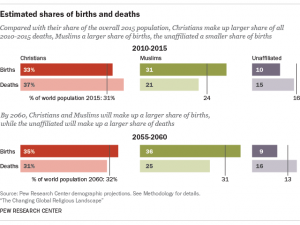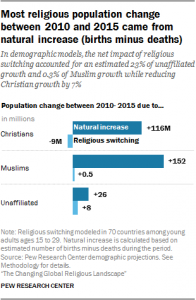More babies were born to Christian mothers than to members of any other religion in recent years, reflecting Christianity’s continued status as the world’s largest religious group. But this is unlikely to be the case for much longer: Less than 20 years from now, the number of babies born to Muslims is expected to modestly exceed births to Christians, according to new Pew Research Center demographic estimates.
Muslims are projected to be the world’s fastest-growing major religious group in the decades ahead, as Pew Research Center has explained, and signs of this rapid growth already are visible. In the period between 2010 and 2015, births to Muslims made up an estimated 31% of all babies born around the world – far exceeding the Muslim share of people of all ages in 2015 (24%).
The world’s Christian population also has continued to grow, but more modestly. In recent years, 33% of the world’s babies were born to Christians, which is slightly greater than the Christian share of the world’s population in 2015 (31%).
While the relatively young Christian population of a region like sub-Saharan Africa is projected to grow in the decades ahead, the same cannot be said for Christian populations everywhere. Indeed, in recent years, Christians have had a disproportionately large share of the world’s deaths (37%) – in large part because of the relatively advanced age of Christian populations in some places. This is especially true in Europe, where the number of deaths already is estimated to exceed the number of births among Christians. In Germany alone, for example, there were an estimated 1.4 million more Christian deaths than births between 2010 and 2015, a pattern that is expected to continue across much of Europe in the decades ahead.
(Click images to enlarge)
Globally, the relatively young population and high fertility rates of Muslims lead to a projection that between 2030 and 2035, there will be slightly more babies born to Muslims (225 million) than to Christians (224 million), even though the total Christian population will still be larger. By the 2055 to 2060 period, the birth gap between the two groups is expected to approach 6 million (232 million births among Muslims vs. 226 million births among Christians).
In contrast with this baby boom among Muslims, people who do not identify with any religion are experiencing a much different trend. While religiously unaffiliated people currently make up 16% of the global population, only an estimated 10% of the world’s newborns between 2010 and 2015 were born to religiously unaffiliated mothers. This dearth of newborns among the unaffiliated helps explain why religious “nones” (including people who identity as atheist or agnostic, as well as those who have no particular religion) are projected to decline as a share of the world’s population in the coming decades.
By 2055 to 2060, just 9% of all babies will be born to religiously unaffiliated women, while more than seven-in-ten will be born to either Muslims (36%) or Christians (35%).
These are among the key findings of a new Pew Research Center analysis of demographic data. This analysis is based on – and builds on – the same database of more than 2,500 censuses, surveys and population registers used for the 2015 report “The Future of World Religions: Population Growth Projections, 2010-2050.” Both reports share the same demographic projection models, but the figures on births and deaths in this analysis have not been previously released.
In addition, this report provides updated global population estimates, as of 2015, for Christians, Muslims, religious “nones” and adherents of other religious groups. And the population growth projections in this report extend to 2060, a decade further than in the original report.
The projections do not assume that all babies will remain in the religion of their mother. The projections attempt to take religious switching (in all directions) into account, but conversion patterns are complex and varied. In some countries, including the United States, it is fairly common for adults to leave their childhood religion and switch to another faith (or no faith). For example, many people raised in the U.S. as Christians become unaffiliated in adulthood, and vice versa – many people raised without any religion join a religious group later in their lives. But in some other countries, changes in religious identity are rare or even illegal.
At present, the best available data indicate that the worldwide impact of religious switching alone, absent any other factors, would be a relatively small increase in the number of Muslims, a substantial increase in the number of unaffiliated people, and a substantial decrease in the number of Christians in coming decades. Globally, however, the effects of religious switching are overshadowed by the impact of differences in fertility and mortality. As a result, the unaffiliated are projected to decline as a share of the world’s total population despite the boost they are expected to receive from people leaving Christianity and other religious groups in Europe, North America and some other parts of the world. And the number of Christians is projected to rise, though not as fast as the number of Muslims.
Global population projections, 2015 to 2060
Christians were the largest religious group in the world in 2015, making up nearly a third (31%) of Earth’s 7.3 billion people. Muslims were second, with 1.8 billion people, or 24% of the global population, followed by religious “nones” (16%), Hindus (15%) and Buddhists (7%). Adherents of folk religions, Jews and members of other religions make up smaller shares of the world’s people.
Between 2015 and 2060, the world’s population is expected to increase by 32%, to 9.6 billion. Over that same period, the number of Muslims – the major religious group with the youngest population and the highest fertility – is projected to increase by 70%. The number of Christians is projected to rise by 34%, slightly faster than the global population overall yet far more slowly than Muslims.
As a result, according to Pew Research Center projections, by 2060, the count of Muslims (3.0 billion, or 31% of the population) will near the Christian count (3.1 billion, or 32%).3
Except for Muslims and Christians, all major world religions are projected to make up a smaller percentage of the global population in 2060 than they did in 2015.4 While Hindus, Jews and adherents of folk religions are expected to grow in absolute numbers in the coming decades, none of these groups will keep pace with global population growth.
Read the rest of this interesting article HERE








































